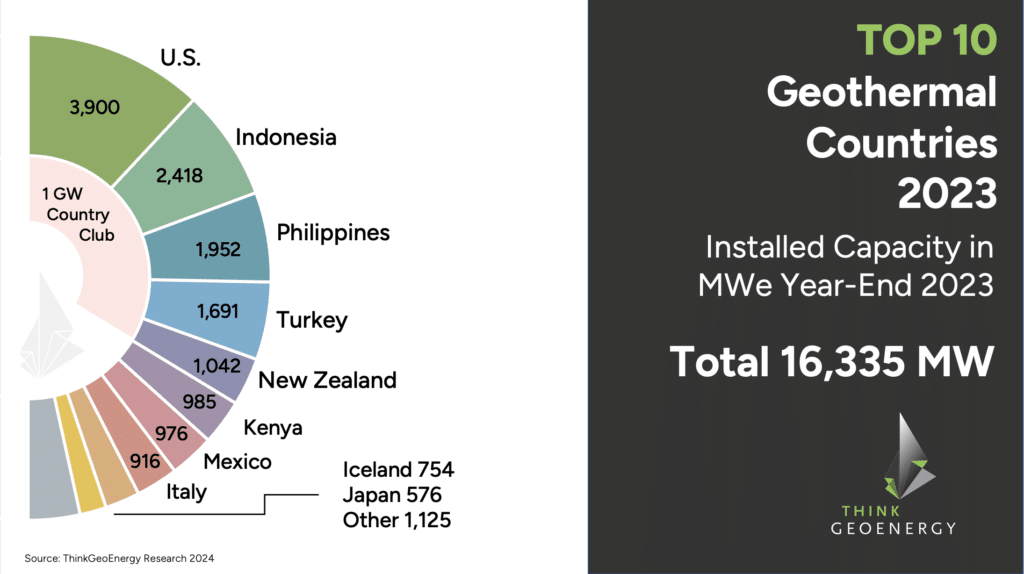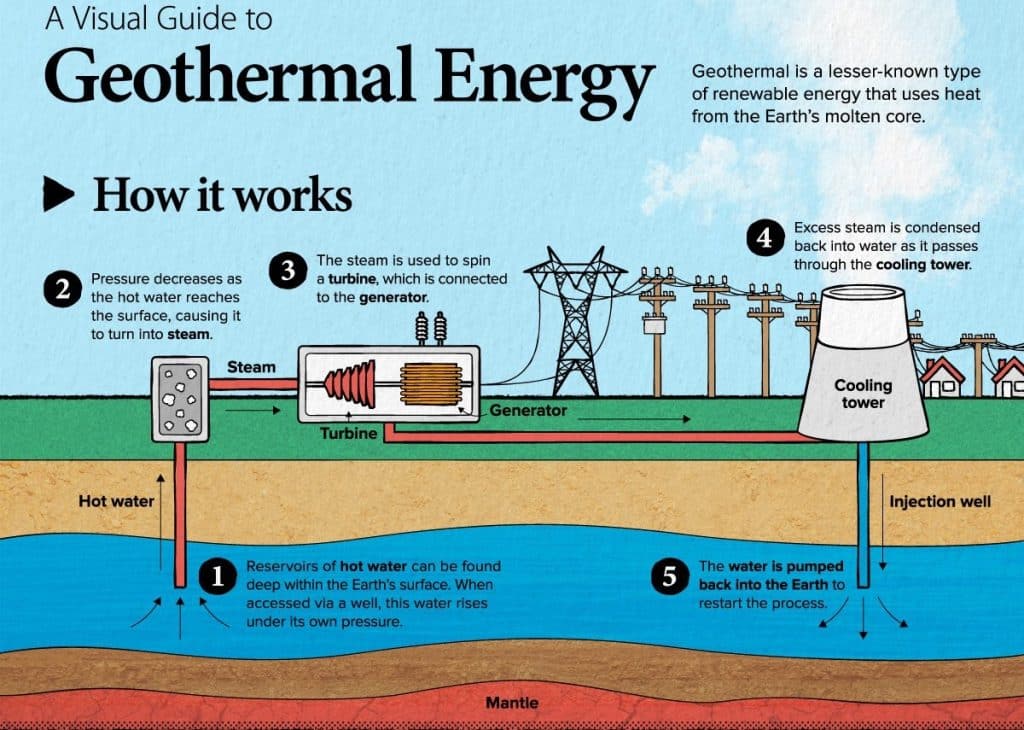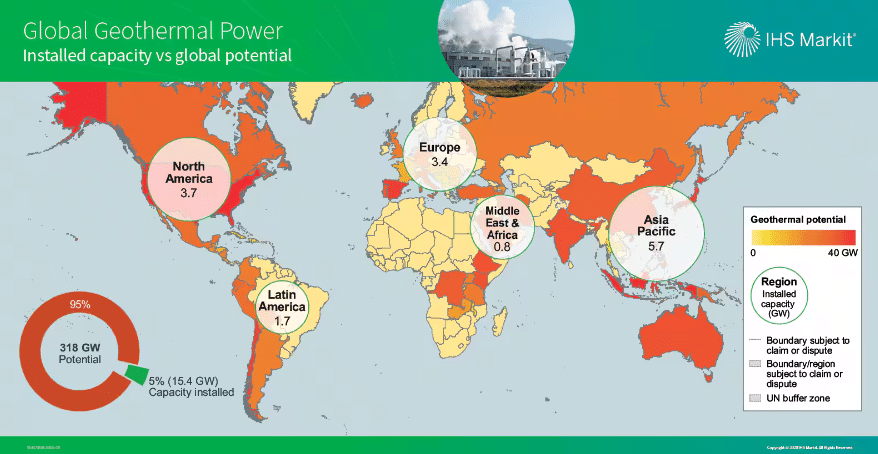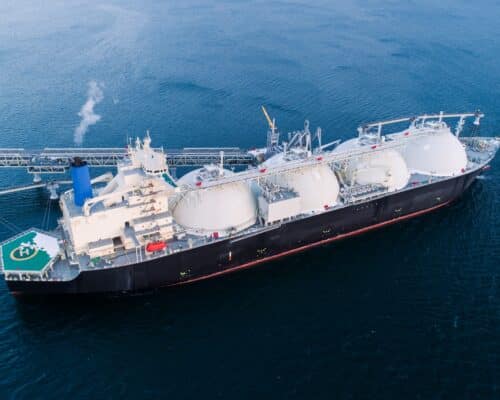Geothermal Energy in the Philippines: A Sustainablity Powerhouse
Source: United Nations Carbon Offset Platform
11 October 2024 – by Eric Koons
Geothermal energy in the Philippines is an essential part of the country’s renewable energy landscape. Its location along the Pacific Ring of Fire gives it access to a large quantity of geothermal resources, like 24 active volcanoes and numerous geothermal fields. As a result, it is one of the world’s top geothermal power producers and plans to expand its capacity in the coming years.
Status of Geothermal Energy in the Philippines
The Philippines is the third-largest producer of geothermal energy globally, after the United States and Indonesia.
The potential geothermal capacity in the Philippines is estimated to be around 4,064 megawatts (MW). Currently, more than 1,900 MW of this potential has been developed and is operational. This accounts for about 14% of the country’s total electricity generation.

This significant contribution in geothermal energy development highlights its vital role in the national grid. The consistent output geothermal energy in the Philippines from geothermal plants ensures a reliable electricity supply unaffected by the intermittency issues faced by other renewable energy sources like solar and wind. This reliability is essential for maintaining industrial productivity and supporting daily life across the archipelago.
How Is Geothermal Energy Used in the Philippines?
The primary use of geothermal energy in the Philippines is electricity generation. Geothermal power plants use the Earth’s internal heat to produce steam, which drives turbines connected to a generator.

This process supplies power to both urban and rural areas, supporting residential, commercial and industrial activities. While direct-use applications such as agricultural drying, aquaculture heating and industrial processes are possible, they are not yet widely used across the world. Expanding these applications could further enhance the benefits of geothermal energy for the Philippine economy.
Geothermal Power Plants in the Philippines
The Philippines hosts several major geothermal power plants strategically located in resource-rich regions.
Makban Geothermal Power Plant
The facility is located on the border of Laguna and Batangas provinces and has an installed capacity of 458 MW. It is one of the largest geothermal plants in the Philippines and plays a vital role in supplying electricity to the Luzon grid.
Tiwi Geothermal Power Plant
Situated in Albay province, the Tiwi plant has a capacity of 157 MW. It was one of the first large-scale geothermal facilities in the Philippines, contributing significantly to the region’s power supply.
Bacon-Manito (BacMan) Geothermal Power Plant
Located across the provinces of Sorsogon and Albay, BacMan has a capacity of 150 MW. It supplies electricity to the Luzon grid and supports the energy needs of the Bicol region.
Geothermal Energy Projects in the Philippines
To further expand its geothermal capacity, the Philippines is actively pursuing several projects.
Maibarara Geothermal Power Project
Located in Batangas province, the Maibarara project began operations in 2014 with an initial capacity of 20 MW. In 2016, a second unit added 12 MW, increasing the total capacity to 32 MW. Plans for a third unit aim to add another 10 MW-30 MW within the next four years.
The project is managed by Maibarara Geothermal Inc., which is a consortium of PetroGreen Energy Corporation, AC Energy Corporation and the state-owned PNOC Renewables Corporation. This exemplifies a successful public-private partnership in the geothermal space.
Kalinga Geothermal Project
This project is located in northern Luzon and spearheaded by the Aragorn Power and Energy Corporation (APEC) in collaboration with international partners. The Kalinga Geothermal Project aims to develop up to 120 MW of geothermal power in the Philippines.
Extensive exploration activities have identified promising geothermal reservoirs. The project is currently in the advanced exploration and development phase, and it has committed to adhering to strict environmental standards and engaging with local Indigenous communities.
Ownership of Geothermal Projects
Developing and operating geothermal projects in the Philippines involves a synergy between government entities and private companies. The Department of Energy (DOE) provides oversight, policy direction and regulatory frameworks to facilitate geothermal energy development. Major private players like the Energy Development Corporation (EDC) and the Philippine Geothermal Production Company are at the forefront of exploration and operational activities.
These companies invest in technology, infrastructure and expertise, driving innovation and efficiency in the sector. The collaborative environment encourages investment, with incentives and partnerships designed to stimulate growth and ensure sustainable management of geothermal resources.
International Renewable Energy Agency: Geothermal’s Role in Energy
The Philippines’ leadership in geothermal energy has not gone unnoticed on the global stage. The International Renewable Energy Agency (IRENA) notes that the country is a prime example of how to effectively harness geothermal resources to achieve sustainable energy goals and reduce carbon emissions and use of fossil fuels in the developing countries. According to IRENA, the global installed geothermal capacity is approximately 15 GW, with the Philippines contributing over 12% of that.

The success of geothermal energy in the Philippines is partly from its progressive policies, such as the Renewable Energy Act of 2008, which have fostered a conducive environment for investment and innovation in the geothermal sector. Furthermore, the Philippines’ participation in the Global Geothermal Alliance, an initiative facilitated by IRENA, demonstrates its commitment to international cooperation in advancing geothermal technology and knowledge sharing.
The Philippines continues to invest in geothermal exploration technologies and capacity building. The International Energy Agency (IEA) targets a tripling of global geothermal capacity by 2030 to align with a net-zero energy scenario. With its ongoing projects and commitment to expanding its geothermal footprint, the Philippines is well-positioned to contribute to this global objective.
This synergy between national efforts and international guidance underscores the Philippines’ role at the forefront of geothermal energy utilisation. The nation’s achievements not only advance its own sustainable development but also set a precedent for other countries with geothermal potential.
by Eric Koons
Eric is a passionate environmental advocate that believes renewable energy is a key piece in meeting the world’s growing energy demands. He received an environmental science degree from the University of California and has worked to promote environmentally and socially sustainable practices since. Eric’s expertise extends across the environmental field, yet he maintains a strong focus on renewable energy. His work has been featured by leading environmental organizations, such as World Resources Institute and Hitachi ABB Power Grids.
Read more





